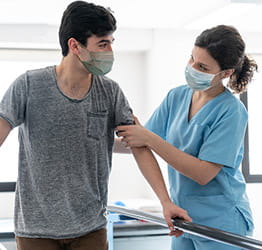Ginny Chomanics knew about macular degeneration long before her own diagnosis. Her mom had the condition, which causes central vision loss over time.
Ginny graduated from Elizabeth Forward High School in Elizabeth, Pa., and attended art school before marrying and having her two daughters. While the girls were in school, she began a career in the cosmetics industry, working for 40 years in a job that allowed her to be creative and interact with people — two things she loved. Ginny also continued painting and interior design to create her own works of art.
After the loss of her first husband, Paul, in 2005, Ginny noticed vision changes in her left eye. She sought care from Thomas Friberg, MD, FACS, an ophthalmologist and professor of ophthalmology at the University of Pittsburgh School of Medicine. He confirmed that Ginny had the beginnings of wet macular degeneration.
The macula is the center part of the retina — the light-sensitive layer at the back of the eye. It’s responsible for central vision, or what you see when you look straight ahead.
There are two types of macular degeneration:
- Dry macular degeneration occurs when the macula becomes thinner and small protein deposits form.
- Wet macular degeneration occurs when abnormal blood vessels grow under the retina, causing fluid and blood to leak.
While macular degeneration doesn’t usually lead to total vision loss, it does make it hard to read and drive or to distinguish fine details and colors.
“It is life-changing,” Ginny says.
After many years of care and eye injections from Dr. Friberg, Ginny became comfortable and dependent on his support, guidance, and devoted treatment. When he took a leave of absence to recover from an accident, Ginny sought care from another practice outside of the UPMC system based on a friend’s recommendation.
But after a bad experience with cataract surgery, she realized she needed to hurry her return to UPMC. She now receives care at the headquarters of the UPMC Vision Institute in the new UPMC Mercy Pavilion.
Ginny sees retina specialist Jay Chhablani, MD, for injections to manage her condition and takes part in occupational therapy with low vision specialist Holly Stants, MS, OTR/L, SCLV, CLVT. She’s also received care from low vision optometrists William Smith, OD, and Jennifer Liu, OD, at the Vision Institute’s Low Vision Clinic.
“Dr. Chhablani is fabulous, always upbeat and smiling when I see him,” Ginny says. "He has the ability to perform my injections painlessly. And Holly does so much homework before my appointments to prepare. She assesses my functional vision and also checks in with me about how I’m feeling emotionally.”
As an artist, losing her ability to distinguish colors has caused Ginny anxiety. But her team’s attention to both her physical and mental health has been extraordinary, she says.
Not only has Ginny received treatment in the new Mercy Pavilion, but her husband Bill, whom she married in 2011, underwent surgery there and is also under the care of Dr. Chhablani.
“I tell everyone, go only to a UPMC doctor,” Ginny says. Today, she and Bill are making the most of life with their family and beloved dog, Andray Oliver.
Ginny’s treatment and results may not be representative of all similar cases.

















